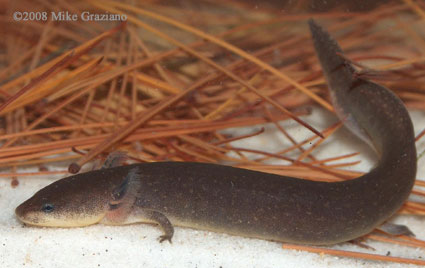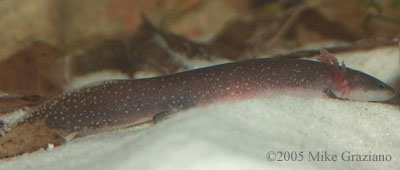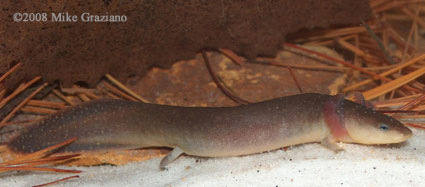| Necturus punctatus | |||||||||
| Dwarf Waterdog | |||||||||

|
|
||||||||
Description
This is the smallest of the waterdogs and has the least amount of patterning. The dorsal surface is gray, and the ventral surface is lighter, producing an obvious contrast. Some individuals are covered in small light and dark flecks. Like all Necturus, this species has four toes on all feet and bright red external gills. The larvae have no stripes and are similar to adults. The adult size is 11.5-19 cm (4.5 - 7.4 in).
Range
The dwarf waterdog is found from southern Virginia to central Georgia. The occurrence of this species is mostly in the Atlantic Coastal Plain (Petranka 1998).
Habitat
This species is found in small to medium sized streams with large amounts of detritus and cover in the form of rocks and logs. Generally, N. punctatus is thought to be a more stagnant water species, so water current is probably less important than in other Necturus habitats.
Comments
Due to the fact that the Neuse River waterdog and the Dwarf Waterdog are sympatric in some areas, they are known to compete for food. The dwarf waterdog is considered fairly common throughout its range, except for being rare in the Neuse and Tar River systems (Braswell and Ashton 1985).


References
Bartlett, R.D. and P. Bartlett 2006. Guide and Reference to the Amphibians of Eastern and Central North America (North of Mexico). University Press of Florida: Gainesville, Florida.
Bishop, S. C. 1943. Handbook of Salamanders. Comstock Publishing Company: Ithaca, NY.
Braswell, A. L., and R. E. Ashton, Jr. 1985. Distribution, ecology, and feeding habits of Necturus lewisi (Brimley). Brimleyana 10:13-35.
Petranka, J. W. 1998. Salamanders of the United States and Canada. Smithsonian Institute Press: Washington DC.
Text © 2009 Ryan St. Laurent
